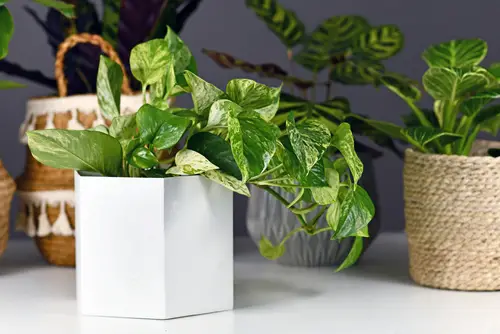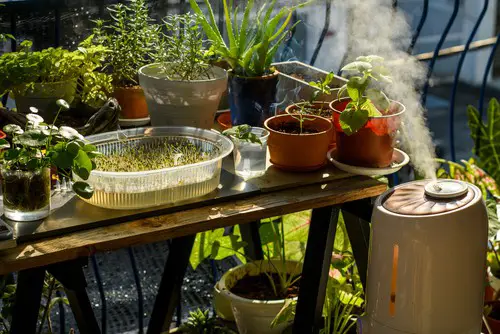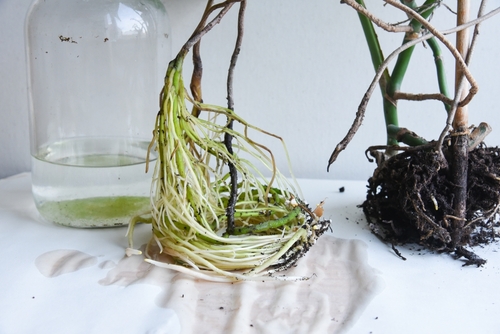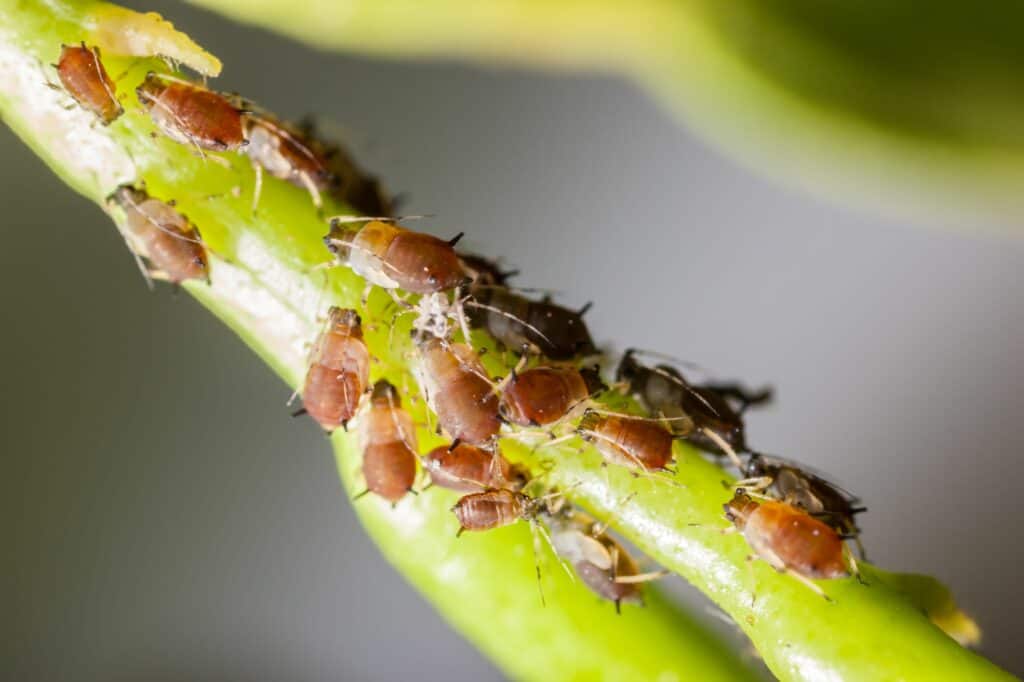Money trees are popular houseplants known for their unique braided trunks and lush green leaves. However, these plants can develop white and brown spots on their leaves, which can be a sign of various problems.
Understanding the causes and symptoms of these issues can help plant owners diagnose and treat the problem effectively. White spots on money tree leaves are often caused by powdery mildew, which is a fungal disease that thrives in humid conditions.
Brown spots, on the other hand, are typically a sign of overwatering or exposure to direct sunlight. These issues can weaken the plant and make it more susceptible to pests and diseases if left untreated. Recognizing the symptoms and taking prompt action can help prevent further damage and restore the plant’s health.
Key Takeaways
- White and brown spots on money tree leaves can be a sign of various problems.
- Powdery mildew, overwatering, and exposure to direct sunlight are common causes of these issues.
- Recognizing the symptoms and taking prompt action can help prevent further damage and restore the plant’s health.
Check out these other posts:
- Squash Leaves Turning Yellow with Brown Spots
- How to Identify and Treat Brown Spots on Snake Plant Leaves
- Small Brown Spots on Pothos Leaves
Understanding Money Tree Leaves

Money trees are popular indoor plants known for their unique braided trunk and lush green foliage. However, like all plants, they can develop issues that can affect their health and appearance.
One common problem that money tree owners may encounter is the development of white or brown spots on the leaves. Understanding the causes of these spots can help you take appropriate action to keep your money tree healthy.
Money Tree Leaves
Money tree leaves are typically bright green and shiny, with a waxy texture. They are generally large and oval-shaped, with a pointed tip and serrated edges. The leaves grow in an alternate pattern along the stem and can range in size from a few inches to over a foot in length, depending on the age and size of the plant.
Photosynthesis
Like all plants, money trees rely on photosynthesis to produce energy and grow. Photosynthesis is the process by which plants convert sunlight into energy, using chlorophyll in their leaves to absorb light and convert it into sugar.
This process is crucial for the health and growth of the plant, as it provides the energy needed for all of its metabolic processes.
White and Brown Spots
White and brown spots on money tree leaves can be caused by a variety of factors. Some common causes of white spots include insect infestations, sunburn, and micronutrient deficiencies. Brown spots, on the other hand, are often caused by overwatering, direct sunlight exposure, or pest infestations.
To treat white spots on money tree leaves, it is important to identify the underlying cause. Insect infestations can be treated with appropriate insecticides, while micronutrient deficiencies can be addressed with fertilizers.
Sunburn can be prevented by keeping the plant out of direct sunlight and providing it with adequate shade. Brown spots caused by overwatering can be addressed by adjusting your watering schedule, while pest infestations can be treated with neem oil or fungicides.
White and Brown Spots on Money Tree Leaves
White and brown spots on Money Tree leaves can be caused by various factors. It is important to identify the cause of the spots to prevent further damage to the plant. Here are some common causes for white and brown spots on Money Tree leaves:
1. Overwatering or Underwatering
Overwatering or underwatering can cause brown spots on Money Tree leaves. When the soil is too wet, it can lead to root rot, which affects the plant’s ability to absorb water and nutrients. On the other hand, when the soil is too dry, the plant can become dehydrated, causing the leaves to turn brown and dry.
2. Direct Sunlight
Direct sunlight can cause brown spots on Money Tree leaves. When the plant is exposed to too much direct sunlight, it can lead to sunburn, which causes the leaves to turn brown and dry. It is important to keep the plant in a shaded area or use a sheer curtain to filter the sunlight.
3. Humidity Level

Maintaining the right humidity level is important for the health of the Money Tree. Low humidity levels can cause the leaves to turn brown and dry, while high humidity levels can lead to fungal infections. It is recommended to maintain a humidity level of at least 50%-60% in the spring and summer.
4. Temperature Stress
Temperature stress can cause brown spots on Money Tree leaves. When the plant is exposed to extreme temperatures, it can lead to leaf scorch, which causes the leaves to turn brown and dry. It is important to keep the plant in a room with a consistent temperature.
5. Water Quality
Using tap water to water the Money Tree can cause white spots on the leaves. Tap water contains minerals that can leave white spots on the leaves. It is recommended to use distilled water or rainwater to water the plant.
6. Fungal Infections and Pest Infestation
Fungal infections and pest infestation can cause white spots on Money Tree leaves. It is important to treat the plant with the appropriate fungicide or insecticide after removing the affected leaves. Neem oil or a fungicide can be used to combat fungal diseases and pest infestations.
Recognizing Symptoms
Money trees are a popular houseplant because they are easy to care for and can prosper in a variety of indoor environments.
However, they are susceptible to various issues that can cause discoloration, yellowing, wilting, browning, leaves curling, blisters, and decline. It is important to recognize the symptoms of these issues to take appropriate measures and prevent further damage.
1. Brown Spots
Brown spots on money tree leaves are a common issue. They are usually caused by environmental factors, such as too much sun or insufficient humidity. Overwatering or underwatering can also cause brown spots. In some cases, pests or diseases may be the culprit.
2. White Spots
White spots on money tree leaves can be natural but could also indicate that your money trees are being attacked by fungi bacteria, insects, and other types of pests. These spots can be caused by calcium, magnesium, copper, manganese, septoria leaf spot, white rot, mosaic virus, sunburn, and pest infestation.
3. Yellowing

Yellowing of money tree leaves can be caused by a lack of nutrients, overwatering, underwatering, or pests. It is important to identify the underlying cause to take appropriate measures.
4. Wilting
Wilting of money tree leaves can be caused by underwatering, overwatering, or pests. It is important to adjust the watering schedule and treat pests promptly to prevent further damage.
5. Leaves Curling
Curling of money tree leaves can be caused by underwatering, overwatering, pests, or environmental factors such as too much sun or insufficient humidity. It is important to identify the underlying cause and take appropriate measures.
6. Blisters
Blisters on money tree leaves can be caused by pests or diseases. It is important to identify the underlying cause and treat promptly to prevent further damage.
7. Decline
Decline of money tree leaves can be caused by a lack of nutrients, overwatering, underwatering, pests, or diseases. It is important to identify the underlying cause and take appropriate measures to prevent further damage.
How to Diagnose Specific Issues
Money trees are relatively easy to care for, but they can still experience issues that can cause brown or white spots on their leaves. To diagnose specific issues, it is important to examine the leaves and consider the conditions in which the plant is growing. Here are some common issues and how to diagnose them:
1. Edema
Edema is a condition that occurs when the plant takes in water faster than it can release it. This can cause the leaves to become swollen and develop brown spots. To diagnose edema, look for brown, blister-like spots on the leaves. The spots may also have a corky texture. Edema is often caused by overwatering or high humidity.
2. Septoria Leaf Spot
Septoria leaf spot is a fungal disease that can cause brown spots on the leaves of the money tree. To diagnose septoria leaf spot, look for small, circular brown spots with a yellow halo. The spots will eventually grow and merge together. Septoria leaf spot is often caused by high humidity and poor air circulation.
3. Powdery Mildew
Powdery mildew is a fungal disease that can cause white spots on the leaves of the money tree. To diagnose powdery mildew, look for white, powdery spots on the leaves. The spots may also have a fuzzy texture. Powdery mildew is often caused by high humidity and poor air circulation.
4. Root Rot

Root rot is a condition that occurs when the roots of the plant are damaged by overwatering or poor drainage. This can cause the leaves to turn yellow or brown and develop spots.
To diagnose root rot, gently remove the plant from its pot and examine the roots. Healthy roots should be white or light brown, while roots affected by root rot will be dark brown or black and may be mushy.
5. Mosaic Virus
Mosaic virus is a viral disease that can cause white or yellow spots on the leaves of the money tree. To diagnose mosaic virus, look for irregularly shaped spots that are yellow or white in color. The spots may also be mottled or streaked. Mosaic virus is often caused by poor hygiene practices, such as using contaminated tools.
6. Money Tree Foliar Blight
Money tree foliar blight is a fungal disease that can cause brown spots on the leaves of the money tree. To diagnose money tree foliar blight, look for brown spots with a yellow halo. The spots may also have a water-soaked appearance. Money tree foliar blight is often caused by high humidity and poor air circulation.
7. Micronutrient Deficiency
Micronutrient deficiencies can cause brown or white spots on the leaves of the money tree. To diagnose a micronutrient deficiency, look for discoloration or spots on the leaves. The specific symptoms will depend on which nutrient is deficient. Common micronutrient deficiencies include iron, manganese, and zinc.
8. White Rot
White rot is a fungal disease that can cause white spots on the leaves of the money tree. To diagnose white rot, look for white, cottony spots on the leaves. The spots may also have a fuzzy texture. White rot is often caused by high humidity and poor air circulation.
By examining the leaves and considering the conditions in which the plant is growing, it is possible to diagnose specific issues with the money tree. Once the issue has been identified, appropriate steps can be taken to treat the problem and prevent it from recurring.
Pests and Diseases Affecting Money Trees
Money trees are generally hardy plants, but they can be susceptible to a variety of pests and diseases. Some of the most common ones are:
1. Mealybugs
Mealybugs are small, soft-bodied insects that feed on plant sap. They are often found in the crevices of leaves and stems, and they can cause yellowing and wilting of the affected plant parts. To get rid of mealybugs, you can use a cotton swab dipped in alcohol to wipe them off the plant.
2. Fungal Disease
Fungal diseases can cause brown spots on money tree leaves. One of the most common fungal diseases is powdery mildew, which can cause white spots on the leaves. To prevent fungal diseases, you should avoid overwatering your plant and ensure that it has good air circulation.
3. Aphids
3. Aphids are small, pear-shaped insects that feed on plant sap. They can cause yellowing and curling of leaves, as well as the production of honeydew, a sticky substance that can attract ants and other insects. To get rid of aphids, you can use a strong stream of water to wash them off the plant.
4. Spider Mites

Spider mites are tiny, spider-like insects that feed on plant sap. They can cause yellowing and wilting of leaves, as well as the production of webbing. To get rid of spider mites, you can use a mixture of water and dish soap to spray the affected plant parts.
5. Thrips and Leaf Miners
Thrips and leaf miners are small insects that feed on plant sap and lay their eggs in the leaves. They can cause yellowing and curling of leaves, as well as the formation of small tunnels in the leaves. To get rid of thrips and leaf miners, you can use a mixture of water and neem oil to spray the affected plant parts.
6. Sooty Mold
Sooty mold is a black, powdery fungus that grows on the honeydew produced by aphids and other insects. It can cause yellowing and wilting of leaves, as well as a decrease in plant growth. To get rid of sooty mold, you should get rid of the underlying insect infestation.
7. Whiteflies
Whiteflies are small, winged insects that feed on plant sap. They can cause yellowing and curling of leaves, as well as the production of honeydew. To get rid of whiteflies, you can use a mixture of water and insecticidal soap to spray the affected plant parts.
Effective Treatment Methods
If you notice white or brown spots on your money tree leaves, it’s important to take action to prevent the problem from getting worse. Here are some effective treatment methods to consider:
1. Identify the Problem
Before treating your money tree, it’s important to identify the problem. The white spots could be caused by oedema, powdery mildew, pest infestation, lack or excess of micronutrients, or other issues.
Brown spots could be caused by foliar blight or other fungal diseases. Once you’ve identified the problem, you can choose the appropriate treatment method.
2. Use Natural Remedies
If you prefer natural remedies, you can try treating your money tree with neem oil, insecticidal soap, or rubbing alcohol. These substances can help control pests and fungal diseases without harming your plant. You can also fertilize your money tree with natural fertilizers to promote healthy growth.
3. Use Fungicides and Insecticides
If natural remedies aren’t effective, you can try using fungicides or insecticides to control the problem. Be sure to choose a product that is safe for indoor use and follow the instructions carefully. You may need to isolate your money tree to prevent the problem from spreading to other plants.
4. Sterilize Your Tools
If you need to prune your money tree or remove affected leaves, be sure to sterilize your tools first. This can help prevent the spread of fungal diseases and pests. You can sterilize your tools with rubbing alcohol or a solution of bleach and water.
Preventive Measures and Care Tips

Proper care and maintenance are essential to prevent white and brown spots from appearing on your money tree’s leaves. Here are some preventive measures and care tips to keep your money tree healthy and spot-free.
1. Watering
Overwatering or underwatering your money tree can lead to various problems, including brown spots on the leaves. To prevent this, water your money tree when the top 1-2 inches of soil is dry. Ensure that the pot has drainage holes to allow excess water to drain out, and avoid leaving the plant sitting in standing water in a saucer.
2. Lighting
Direct sunlight can cause sunburn and white spots on your money tree’s leaves. Therefore, it is best to place your money tree in a bright, indirect light location. If you notice white spots on your money tree’s leaves, move it to a shadier spot.
3. Nutrients
Lack or excess of nutrients, such as iron, manganese, calcium, and copper, can cause brown spots on your money tree’s leaves. Ensure that your money tree is getting the proper nutrients by fertilizing it every two weeks during the growing season. You can use a balanced fertilizer or a fertilizer specifically formulated for money trees.
4. Humidity and Air Circulation
Maintaining a humidity level of at least 50%-60% can prevent white spots caused by dry air. You can increase the humidity around your money tree by misting it regularly or placing a tray of water near it. Ensure that your money tree has adequate air circulation by placing it in an area with good airflow.
5. Soil and Pot
Using the right soil and pot can also prevent brown spots on your money tree’s leaves. Use a well-draining soil mix that is rich in organic matter. Ensure that the pot is the right size for your money tree, with enough room for growth. Repot your money tree every two years to ensure that it has enough space to grow.
6. Cleaning
Keeping your money tree’s foliage clean can prevent the buildup of dust and debris, which can lead to brown spots. Wipe the leaves with a damp cloth regularly to keep them clean.
How to Propagate a Healthy Money Tree
Propagating a healthy money tree is a great way to get new plants without having to buy them. Money trees, also known as Pachira aquatica, can be propagated using stem cuttings or air layering. Here are some steps to follow for successful propagation:
Stem Cuttings

- Choose a healthy stem that has at least two nodes. Nodes are the areas where leaves and roots grow from the stem.
- Cut the stem at a 45-degree angle using a sharp, clean knife or scissors. Make sure the cutting is at least 6 inches long and has a few leaves.
- Remove the leaves from the bottom half of the stem. This will help the cutting focus on growing roots instead of supporting leaves.
- Dip the cut end of the stem into rooting hormone powder. This will help encourage the stem to grow roots.
- Plant the stem cutting in a pot filled with well-draining soil. Water the soil until it is moist but not soggy.
- Cover the pot with a plastic bag or plastic wrap to create a humid environment. This will help the cutting retain moisture and encourage root growth.
- Place the pot in a bright, indirect light. Avoid direct sunlight as it can scorch the cutting.
- Check the soil regularly and water as needed. Avoid letting the soil dry out completely or sitting in standing water.
Air Layering
- Choose a healthy stem that is at least one year old. Look for a section of the stem that is about 1 inch in diameter.
- Make two parallel cuts around the stem, about 1 inch apart. Remove the bark and expose the inner wood of the stem.
- Wrap the exposed section of the stem with damp sphagnum moss. Make sure it is firmly in place and cover it with plastic wrap to keep it moist.
- Wait for roots to grow from the exposed section of the stem. This can take several weeks to several months.
- Once roots have grown, cut the stem below the rooted section and plant it in a pot filled with well-draining soil. Water the soil until it is moist but not soggy.
- Place the pot in a bright, indirect light. Avoid direct sunlight as it can scorch the cutting.
- Check the soil regularly and water as needed. Avoid letting the soil dry out completely or sitting in standing water.
Conclusion
The appearance of white or brown spots on Money Tree leaves can be caused by various factors. Overwatering, direct sunlight exposure, insect infestation, micronutrient deficiency, fungal diseases, and viral infections are some of the most common causes of these spots.
To prevent and treat white and brown spots on Money Tree leaves, it is essential to maintain proper growing conditions. This includes providing adequate water, light, and nutrition, as well as protecting the plant from pests and diseases.
If the plant is already affected, the following steps can be taken to address the issue:
- Remove affected leaves and dispose of them properly.
- Treat the plant with the appropriate fungicide or insecticide, depending on the type of infection or infestation.
- Adjust the plant’s growing conditions, such as reducing watering or moving it to a spot with less direct sunlight.
- Monitor the plant closely and take prompt action if any new spots or symptoms appear.
Frequently Asked Questions

How can I treat brown spots on my Money Tree leaves?
Brown spots on Money Tree leaves can be caused by a variety of factors, including overwatering, underwatering, or exposure to direct sunlight. To treat brown spots, it’s important to identify the underlying cause and take appropriate action.
If your Money Tree is overwatered, reduce the frequency and amount of watering. If it’s underwatered, increase watering and ensure adequate drainage. If it’s exposed to direct sunlight, move it to a shadier location.
In addition, you can use a fungicide or insecticide to treat any pests or fungal infections that may be causing the brown spots.
What causes white spots on Money Tree leaves?
White spots on Money Tree leaves are most likely due to a fungal infection or pests. Fungal infections can be caused by overwatering, poor drainage, or high humidity. Pests such as spider mites, mealybugs, and thrips can also cause white spots on leaves.
To treat white spots on Money Tree leaves, it’s important to identify the underlying cause and take appropriate action. If it’s a fungal infection, use a fungicide and improve drainage. If it’s pests, use an insecticide and isolate the plant to prevent spread.
What are the signs of Anthracnose leaf spot on Money Trees?
Anthracnose leaf spot is a fungal disease that can affect Money Trees. The signs of Anthracnose leaf spot include small, circular lesions on the leaves that are brown or black in color. The lesions may have a yellow halo around them and can cause the leaves to wilt and die.
To prevent Anthracnose leaf spot, avoid overwatering and improve drainage. If your Money Tree is already infected, use a fungicide and remove any infected leaves.
What are some common diseases that affect Money Trees?
In addition to Anthracnose leaf spot, Money Trees can be affected by a variety of other diseases. These include root rot, powdery mildew, and leaf spot. Root rot is caused by overwatering and poor drainage and can cause the roots to rot and the plant to wilt and die.
Powdery mildew is a fungal infection that can cause a white, powdery coating on the leaves. Leaf spot is a fungal infection that can cause brown or black spots on the leaves.
How can I prevent fungus from growing on my Money Tree?
To prevent fungus from growing on your Money Tree, it’s important to avoid overwatering and improve drainage. Make sure the soil is well-draining and allow the top inch of soil to dry out before watering.
In addition, avoid getting water on the leaves, as this can create a humid environment that is conducive to fungal growth. If you notice any signs of fungal infection, use a fungicide and remove any infected leaves.
What are the best ways to care for a Money Tree?
To care for a Money Tree, it’s important to provide it with the right growing conditions. Money Trees prefer bright, indirect light and well-draining soil. Water the plant when the top inch of soil is dry and avoid overwatering.
In addition, fertilize the plant every two weeks during the growing season with a balanced fertilizer. Finally, prune the plant as needed to maintain its shape and remove any dead or damaged leaves.

Hey, I’m Lisa and I’ve been an avid gardener for over 30 years. I love writing, talking and living in the garden! Feel free to connect with me on my socials below

